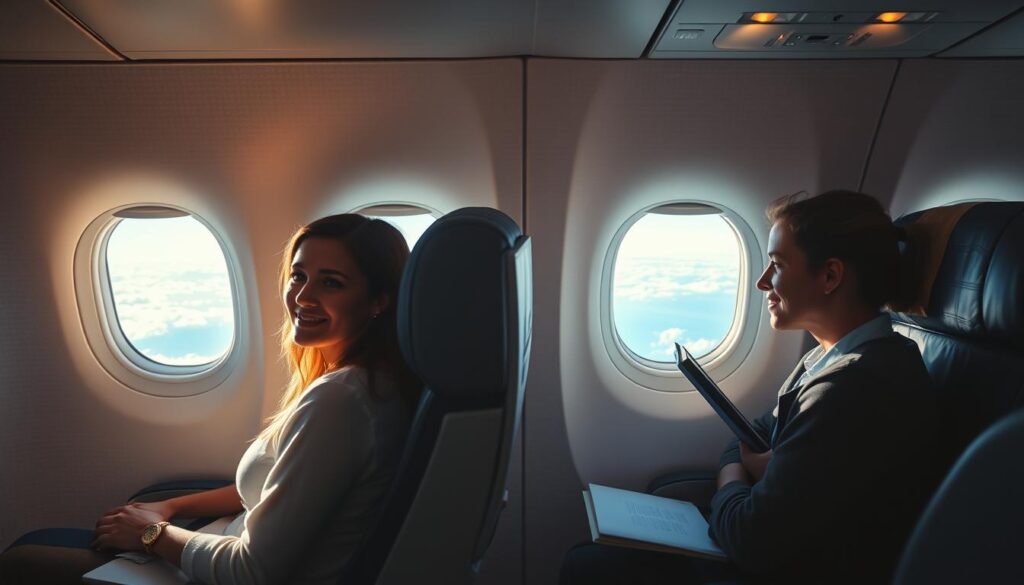Is the Window Seat Really Safer?
When it comes to flying, safety is a top concern for many passengers. One question that often arises is whether the window seat is safer than other seats on the plane. According to various studies, the safety of a seat on an airplane depends on several factors, including the location of the seat and the type of emergency.
Airplane seat safety is a complex topic, and there’s ongoing debate about which seat is the safest. In this article, we’ll explore the factors that affect seat safety and provide insights into the safest seats on a plane.
By examining the data and expert opinions, we’ll help you make informed decisions about your seat choice on your next flight.
The Great Seat Debate: Window vs. Aisle
The window seat and aisle seat have their own set of advantages and disadvantages, sparking a heated debate among travelers. When deciding between these two options, passengers must consider several factors, including safety, comfort, and convenience.
Window seats are often preferred by those who want to lean against the plane’s wall and enjoy the view. However, they also mean being confined to your seat for the duration of the flight if you don’t want to disturb your neighbors. On the other hand, aisle seats offer more freedom to move around and easier access to the lavatory, but they also expose you to more foot traffic and potential disturbances.

In terms of safety, both window and aisle seats have their pros and cons. For instance, being closer to the aisle might make it easier to exit the plane quickly in an emergency. Conversely, the window seat is further from the aisle, potentially reducing the risk of being hit by passing carts or disturbed by other passengers.
Studies and statistics on airplane seat safety often yield mixed results, with some suggesting that the rear of the plane is safer, while others argue that the front is preferable. However, when it comes to the debate between window and aisle seats, the evidence is not conclusive, suggesting that other factors like personal preference play a significant role.
Ultimately, the choice between a window and an aisle seat depends on what matters most to the individual traveler. Whether it’s the view, the ease of movement, or perceived safety, understanding the pros and cons of each can help make an informed decision.
Is the Window Seat Really Safer? The Evidence
The safety of window seats on airplanes has been a topic of debate, with some studies suggesting they may be safer than other seats. To understand this claim, it’s essential to examine the available evidence for window seat safety and relevant airplane accident data.
A notable study analyzed by Time magazine over a period of 35 years provides valuable insights. According to this study, the middle rear seats had a lower fatality rate compared to other seats on the plane. While this doesn’t directly prove that window seats are safer, it does indicate that certain areas of the plane are more survivable in the event of an accident.

When looking at window seat safety statistics, it’s crucial to consider various factors, including the location of the seat within the aircraft and the type of accident. The data suggests that being closer to the rear of the plane and being in a window seat may offer some advantages in terms of safety.
Airplane accident data analysis is complex and involves numerous variables. However, studies have consistently shown that certain seating configurations are associated with different survival rates. For instance, seats that are closer to exits, whether they are window, aisle, or middle seats, tend to have higher survival rates due to easier evacuation routes.
The evidence supporting the safety of window seats is not conclusive but suggests that there are scenarios where they might be advantageous. For example, in the event of a crash, being in a window seat might reduce the risk of injury from other passengers or debris. However, more research is needed to definitively state that window seats are safer.
In conclusion, while there is some evidence to suggest that window seats may have a safety advantage under certain conditions, it’s essential to consider all available data and statistics. Travelers should be aware of the factors that influence safety, including seat location and aircraft design.
Safety Advantages of Window Seats
The safety benefits of choosing a window seat on a plane are multifaceted and worth exploring. One of the primary advantages is the ability to control your environment more effectively.
Light and Temperature Management
Having a window seat allows you to manage light and temperature to your liking. You can adjust the window shade to control the amount of light entering, which can be particularly beneficial during long flights or when trying to sleep.
Moreover, being near the window gives you some influence over the airflow and temperature around you, as you can adjust the vent above. This can enhance your comfort and potentially reduce the risk of discomfort-related issues during the flight.

Another significant safety advantage of the window seat is the reduction in disturbances. You are less likely to be disturbed by other passengers or crew members, as you are not in the main aisle or adjacent to other seats as frequently.
This reduced interaction can minimize the risk of close contact with others who may be sick, potentially lowering your risk of getting infected during the flight.
By choosing a window seat, travelers can enjoy a safer, more controlled flying experience. The combination of better environmental control and reduced disturbances contributes to the overall safety benefits associated with window seats.
When Aisle Seats Might Be Safer
In specific emergency scenarios, aisle seats might offer a safer exit strategy. One of the primary advantages of aisle seats is the ease of access they provide during an emergency evacuation.
Emergency evacuation is a critical situation where the benefits of an aisle seat become apparent. Being closer to the aisle means you have a more direct route to the nearest exit, which can be crucial in situations where every second counts.
Aisle seats also offer more flexibility during an evacuation. If the exit is blocked or if there’s a need to assist someone else, having the aisle seat allows for easier movement. This can be particularly important in emergency situations where the ability to move quickly and safely is paramount.
Furthermore, in the event of an emergency, the crew’s instructions often emphasize the importance of leaving personal belongings behind. From an aisle seat, it’s easier to comply with these instructions without having to climb over other passengers, thereby reducing potential obstacles during the evacuation process.
While the safety advantages of aisle seats are significant in emergency evacuations, it’s also worth noting that these situations are rare. Nonetheless, understanding the potential benefits can help travelers make informed decisions when choosing their seats.
Beyond Safety: Other Factors to Consider
Beyond the safety considerations, other factors play a significant role in selecting the perfect seat on a flight. While safety is crucial, comfort, convenience, and specific needs can greatly impact your flying experience.
For Anxious Flyers
For those who experience anxiety during flights, choosing the right seat can make a significant difference. Window seats can provide a sense of security and comfort, as they offer a view and a place to lean against. Additionally, being away from the aisle can reduce anxiety related to other passengers and cabin crew walking by.
Some airlines offer additional support for anxious flyers, such as extra legroom or specific calming amenities. It’s worth exploring these options when booking your flight.
Frequent business travelers often have different priorities when it comes to seat selection. Proximity to the lavatory or galley can be a consideration for those who need to be accessible. However, seats near these areas can also be noisy and have more foot traffic.
For business travelers, having easy access to power outlets and the ability to work comfortably during the flight are key factors. Seats near power outlets or in areas with more legroom can be particularly beneficial.
For Families with Children
Families traveling with children have unique needs when it comes to seat selection. Booking seats together is a top priority to ensure that family members can sit together. Some airlines offer family-friendly seating options or the ability to pre-book seats together.
For families with infants, being near the lavatory can be helpful for changing diapers. Additionally, some aircraft have basin seats or baby bassinet options on certain flights, which can be a significant advantage for families.
Ultimately, the best seat for you will depend on your individual needs and priorities. By considering factors beyond safety, such as comfort, convenience, and specific requirements, you can make an informed decision that enhances your flying experience.
Conclusion: Making Your Seat Selection
When it comes to choosing a seat on a plane, being informed is key. Understanding the safety advantages and disadvantages of window and aisle seats can help you make a more informed decision.
Consider your individual needs and priorities when making your seat selection. If you’re looking for more legroom or easier access to the aisle, an aisle seat might be the better choice. On the other hand, if you prefer a more stable ride or a view, a window seat could be the way to go.
To make the best choice, consider airplane seat tips such as opting for a seat near the front of the plane or choosing a seat with more legroom. By being mindful of these factors, you can ensure a more comfortable and enjoyable flight.
Ultimately, the decision comes down to your personal preferences and needs. By being informed and prepared, you can make the most of your flying experience and choose a seat that suits you best.
